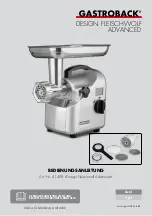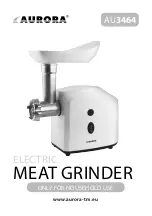
11 ENGLISH
Press shaft lock firmly and tighten Ezynut by turning the
abrasive wheel clockwise as far as it turns.
Turn the outside ring of Ezynut counterclockwise to
loosen.
►
Fig.13:
1.
Arrow
2.
Notch
►
Fig.14
NOTE:
•
Ezynut can be loosened by hand as long as
the arrow points the notch. Otherwise a lock
nut wrench is required to loosen it. Insert one
pin of the wrench into a hole and turn Ezynut
counterclockwise.
Installing or removing flex wheel
(optional accessory)
WARNING:
•
Always use supplied guard when flex wheel is
on tool. Wheel can shatter during use and guard
helps to reduce chances of personal injury.
►
Fig.15:
1.
Lock nut
2.
Flex wheel
3.
Plastic pad
4.
Inner flange
Follow instructions for depressed center wheel but also
use plastic pad over wheel. See order of assembly on
accessories page in this manual.
Installing or removing abrasive disc
(optional accessory)
NOTE:
•
Use sander accessories specified in this man
-
ual. These must be purchased separately.
►
Fig.16:
1.
Sanding lock nut
2.
Abrasive disc
3.
Rubber pad
Mount the rubber pad onto the spindle. Fit the disc on
the rubber pad and screw the sanding lock nut onto the
spindle. To tighten the sanding lock nut, press the shaft
lock firmly so that the spindle cannot revolve, then use
the lock nut wrench and securely tighten clockwise.
To remove the disc, follow the installation procedure in
reverse.
Installing or removing dust cover
attachment (Optional accessory)
WARNING:
•
Always be sure that the tool is switched off
and unplugged before installing or removing
the dust cover attachment.
Failure to do so
causes damage to the tool or a personal injury.
There are four pieces of dust cover attachment and
each is used in one of different positions.
►
Fig.17:
1.
Marking A
2.
Marking B
3.
Marking C
4.
Marking D
Set the dust cover attachment so that the marking (A, B,
C or D) places as shown. Snap its pins in the vents.
Dust cover attachment can be removed by hand.
NOTE:
•
Clean out the dust cover attachment when it is
clogged with dust or foreign matters. Continuing
operation with a clogged dust cover attachment
will damage the tool.
OPERATION
WARNING:
•
It should never be necessary to force the tool.
The weight of the tool applies adequate pres
-
sure. Forcing and excessive pressure could
cause dangerous wheel breakage.
•
ALWAYS replace wheel if tool is dropped while
grinding.
•
NEVER bang or hit grinding disc or wheel onto
work.
•
Avoid bouncing and snagging the wheel, espe
-
cially when working corners, sharp edges etc.
This can cause loss of control and kickback.
•
NEVER use tool with wood cutting blades and
other saw blades. Such blades when used on a
grinder frequently kick and cause loss of control
leading to personal injury.
CAUTION:
•
Never switch on the tool when it is in contact
with the workpiece, it may cause an injury to
operator.
•
Always wear safety goggles or a face shield
during operation.
•
After operation, always switch off the tool and
wait until the wheel has come to a complete stop
before putting the tool down.
Grinding and sanding operation
►
Fig.18
ALWAYS hold the tool firmly with one hand on housing
and the other on the side handle. Turn the tool on and
then apply the wheel or disc to the workpiece.
In general, keep the edge of the wheel or disc at an
angle of about 15° to the workpiece surface.
During the break-in period with a new wheel, do not
work the grinder in the B direction or it will cut into
the workpiece. Once the edge of the wheel has been
rounded off by use, the wheel may be worked in both A
and B direction.
Operation with abrasive cut-off /
diamond wheel (optional accessory)
►
Fig.19:
1.
Lock nut
2.
Abrasive cut-off wheel/dia
-
mond wheel
3.
Inner flange
4.
Wheel guard
for abrasive cut-off wheel/diamond wheel
The direction for mounting the lock nut and the inner
flange varies by wheel thickness. Refer to the table
below.












































